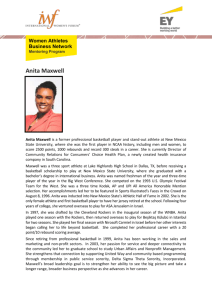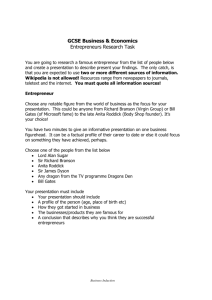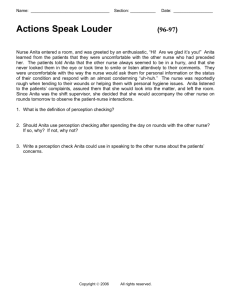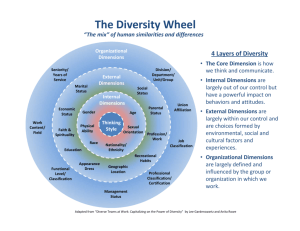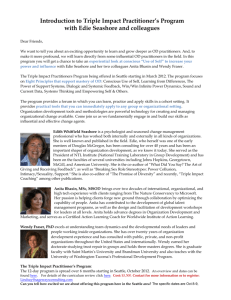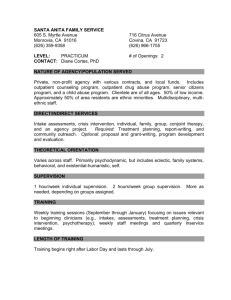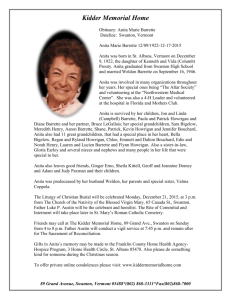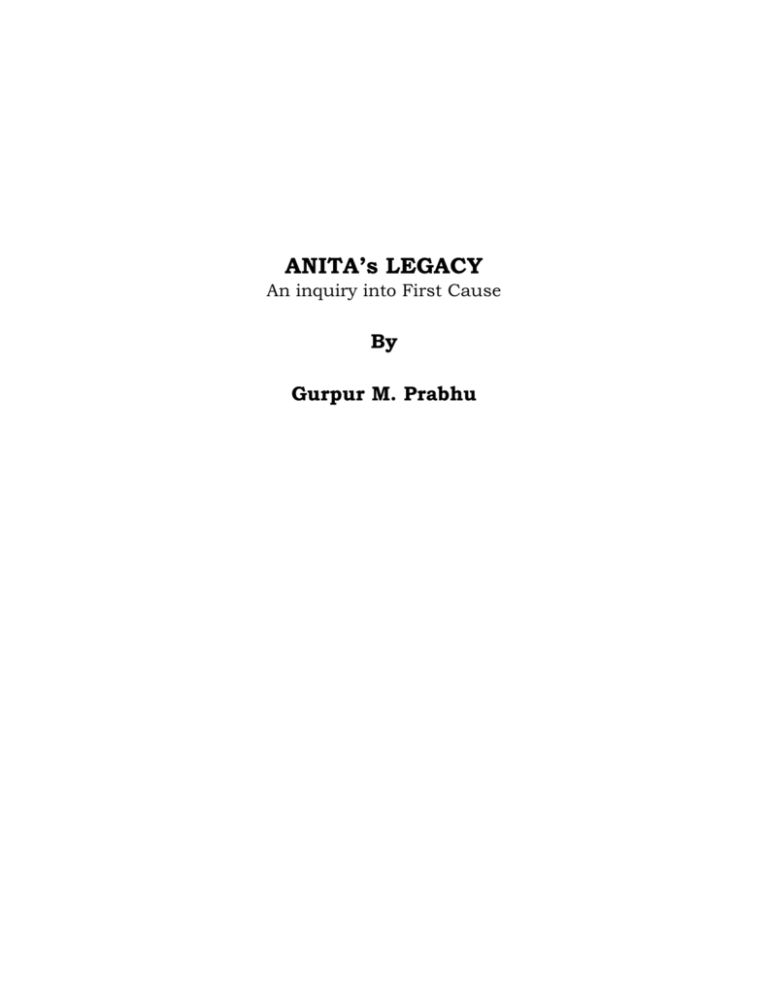
ANITA’s LEGACY
An inquiry into First Cause
By
Gurpur M. Prabhu
“ From the unreal lead me to the real,
From darkness lead me to light,
From death lead me to immortality.”
—Brihadaranyaka Upanishad
“The Great Spirit that breathes through our bodies is
our permanent cosmic legacy. Our purpose in life is
to emancipate this Spirit and help It understand Its
true nature — that of pure Consciousness . . . . a
Consciousness that is present in the tappets of a
motorcycle engine, in the petals of a flower, in the
many statues of God worshipped everyday and
inside each and every one of us.”
—Gurpur M. Prabhu
2
Reader Praise
For
ANITA’s LEGACY
“I enjoyed the writing in your book. You have the gift
for transmitting complexities clearly, and that is a rare
thing.”
— John Oakes,
Publisher of Four Walls Eight Windows
“Obviously I take great pleasure in going through the
books which touch upon the person and the legend of
Hypatia of Alexandria. But in Prabhu’s book there is
something more. Restoring to us the times in which the
discrepancy between science and mysticism was unknown,
he encourages us to direct our efforts to both these
objectives simultaneously and to derive therefrom the
paradigm for scientists who today are confused about
the mystery of God. And although I resent some of
Prabhu’s remarks about Christianity, I find the purpose
of his novel admirable.”
— Professor Maria Dzielska,
Author of Hypatia of Alexandria
“Finally a bold book that deals with issues that Carl
Sagan misses way off the mark, and that Robert Pirsig
gingerly tiptoes around. It has changed the way I think
and feel about God and the universe and my place in it.”
— Vikram Rao
3
“I have read your book more than once and enjoyed it
very much. I’ve highlighted many passages where your
power of expression has been fantastic.”
— Professor V. Krishnamurthy, Author of Science and
Spirituality, www.geocities.com/profvk/
“Mr. Prabhu is an excellent writer. He shows a mastery
of the subject matter as few have in recent times. Couple
that with his powerful fiction narrative that interweaves
the spectrum of philosophy, science, and religion, and
you have a book that is gripping from beginning to the
very end.”
— Cdr. H. S. P. Vittal
“I was fascinated by your book. It enabled me to become
familiar with alternative paradigms to Western thought
on issues of theology. In establishing a connection with
science you have performed a great service to a much
wider audience of interested readers who are struggling
with their spirituality. The fiction format engrossed me
and I was reminded of The Goal by Eliyahu Goldratt, a
book on business process improvement that is also
written as a novel.”
— Professor John
Wong
“A powerful, thought-provoking book. By unifying
physics, metaphysics, philosophy and spirituality in a
spell-binding story, you answered some of my questions,
generated several more, and opened new doors on my
journey towards the discovery of truth.”
— Dawn Adams
4
“I finished the book in 4 days, very quickly!! I was
absorbed by it and you succeeded in maintaining the
reader’s interest from the beginning until the end. The
book made me think a lot about the values in this life
and the purpose of it. I tend to believe there is a
universal religion no matter what is the religion you
practice or you are taught when you are a child and I
found this trend in the book. You have all my
admiration.”
— Angie Trius
“A book that I will treasure for its insights into the most
fundamental question of first cause. I prefer biographical
novels to straight biographies, and especially enjoyed
this allegorical unification of philosophy, science, and
religion. It’s a book I can come back to again with
interest and enthusiasm.”
— Professor Art Gittleman
“I really enjoyed the book and found the idea very
original. It is such a joyful book and should be read by
many people. With all the wars over religion and science
it is refreshing to see that they do have a common
meeting ground. I know I would enjoy reading this more
times.”
— Robert Krol
“Since I read your book, it has helped me achieve the
spirituality and peace that I’ve been searching for. I just
couldn’t put it down.”
— Mary McIntyre
5
“A masterful piece of fiction, enlivening the debate on
the search for truth. I read it in five hours straight and
thoroughly enjoyed it.”
— Amrit Yegnanarayan
“When I started reading the book I didn’t like it much
because it seemed to attack my Christian faith. But then
as I read some more, the universality of religion
appealed to me a lot. When I reached the end I could not
stop crying.”
— Teresa Friederich
6
This book is a fictional dramatization of a metaphysical
and spiritual journey. Names, characters, places, and
incidents are products of the author’s imagination or are
used fictitiously. Any resemblance to actual events or
locales or persons, living or dead, is entirely
coincidental.
Copyright © 1997 by Gurpur M. Prabhu
All rights reserved. No part of this manuscript may be
reproduced or transmitted in any form or by any means,
electronic or mechanical, including photocopying,
recording, or by any information storage and retrieval
system, without explicit permission in writing from the
author.
Grateful acknowledgment is made for permission to
reprint the following:
Excerpt from Zen and the Art of Motorcycle
Maintenance by Robert M. Pirsig. Copyright 1974
by Robert M. Pirsig. Reprinted by permission of
William Morrow and Company.
Lyrics from Welcome Back Kotter by John
Sebastian. Reprinted by permission of John
Sebastian Music.
Picture on front cover. R Barba, College of
Education, San Jose State University.
7
In this world, there have always been, there are,
and there will always be original thinkers and those that
follow. Our ancestors in the years gone by, both men
and women, were not only leading original thinkers but
also assumed the proportion of giants among generals.
They strived hard to point us toward the Word of God,
but time and time again, our path to Truth has been
diverted by those who choose to control us, not help us
out. This book is dedicated to those ancestors of ours
who repeatedly rise from the ashes and try their best to
help us find the Truth.
8
“In questions of science the authority of a thousand is
not worth the humble reasoning of a single individual.”
— Galileo Galilei, circa 1600 A.D.
Author’s Note:
This book is an inquiry into The Question: why
is there something instead of nothing? Religion believes
that The Answer is the Supreme Being called God.
Science believes that the road to The Answer goes
exclusively through astronomy, cosmology, and physics.
Not so. The road goes through several other places:
through metaphysics, through philosophy, through
religion, and through each and every one of us. We are
all children of the cosmos and have a fundamental right
to ask The Question and find an answer for ourselves.
The material presented in these pages is not to
be confused with invaluable research being done by
scientists. Nor is it to be confused with the abounding
scholarly literature in philosophy and theology.
Nevertheless the book deals with a fair amount of
physics, metaphysics, philosophy, and spirituality.
A word or two about the narrative. The first
draft was written through me at a phenomenal pace. It
was written during the hours of 9:00 PM to 4:00 AM, it
was written in the short span of two months, and it was
my first experience with the Writing Muse. Such power
she wielded over me that I obeyed her every whim in the
fall of 1996. To remain faithful to her I have retained the
original fiction structure of that draft as much as
possible.
Several readers have commented on the book’s
spiritually uplifting and inspirational theme. My hope is
that you will be a slightly different person, that you will
9
begin to think differently, that you will challenge basic
assumptions, that you will see the universe differently,
than before you read this book. If you are such a reader,
please pass it on to your friends.
Although much has been changed for rhetorical
purposes, the substantive portion of the inquiry is a
personal saga, and consists of my father’s thoughts over
a period of 50 years. My only regret is that it did not get
written in time for my mother to read it. Not having had
much scientific training, I would like to believe that she
would have found the story compelling and perhaps
understood him a little better.
Anita’s Legacy is written in loving tribute to my
father, Major K.
10
Prologue
Thursday,
May 2, 1996 was a cool day in the
midwestern United States. Anita did not wake up at the
normal time for school in the morning. She would not
wake up ever again. She had died peacefully in her sleep
with a smile on her face. It was a heart-wrenching
experience for her mother Meg and her father Alan to
lose their only child, about two weeks short of her 16th
birthday.
When Major Kay, their neighbor down the
street, heard the news, he rushed over at once. Major
Kay was a 71-year-old retired army officer. Gardening
was his hobby, but physics and philosophy were his
passion. He had been a good family friend and his
grandson, Chris, was Anita’s classmate. Anita used to
visit their house frequently.
Nobody, not even his wife or his army buddies
had seen the major cry, but on this day Major Kay’s
11
tears could not be contained. He and Anita had been
soul mates for several years. They had spent hours
together discussing physics, philosophy, and religion.
Anita’s kinship with Major Kay was even stronger than
her kinship with her father.
She had told her mother that she was to be
cremated and her ashes to be dropped in the vicinity of
Mt. St. Helens in the state of Washington.
At the memorial service held on May 5th, Major
Kay was the last to speak. He said: “We all know what a
sweet girl Anita was. She touched our lives in different
ways during her short stay on earth. I would be remiss in
my duty if I did not talk about a facet of her that is
unknown to many of you.
“Since the beginning of civilization, people have
wondered about the purpose of life and the origins of the
universe. We ask ourselves where we came from, why
we are here, and where we are going. We desperately
look for answers. Science looks for answers in the quest
for a single theory that describes the whole universe.
Religion embraces the principle of a Supreme Being and
looks for answers in the Word of God.
“Anita too was curious about many things. In
the 12 years that I have been her friend, she has pestered
me with lots of questions. The funny thing about her
questions was that they usually altered my thinking and
forced me to come up with answers. These answers have
given me a totally different picture of the universe and
the concept of God. Because of her probing, I believe
things today that I would not have dreamed of believing
a few years ago.
“Anita was fascinated by astronomy. To her, it
was the queen of all the sciences. I cannot forget the
12
gleam in her eyes when she gazed at the heavens. She
would wake up before sunrise, and point her binoculars
towards the summer triangle of Vega, Altair, and Deneb.
Then she would eagerly wait for the constellation
Andromeda to rise, wherein lies the nebula Messier 31,
believed to be the twin of our galaxy.
“During the last six weeks she was transfixed by
the appearance of Hyakutake. The comet is named after
an amateur Japanese astronomer who discovered it less
than two months before it could be viewed with the
naked eye. It literally came out of the blue, surprising,
and even embarrassing many respected astronomers. For
us in the northern hemisphere it was a truly spectacular
sight. Anita followed the comet with great interest as it
continued to brighten along the northern byway of the
sky—from Arcturus to the Big Dipper’s handle, through
Ursa Minor, and on into Perseus before fading away
from us. I stayed awake with her a couple of nights
watching the comet’s mighty tail from dusk till dawn.
“Her death coincided with the day darkness
descended on Hyakutake. On May 2nd, it turned around
the sun and will be dark for the next two weeks, hidden
by the sun’s glare. Like the comets in the night sky, I
pray that her soul shines forever in the far reaches of the
universe.
“Anita’s favorite smell was rain falling on dry
sand. I recall standing outside with her during the first
showers this year. As we smelled the sand and became
wet, she asked me, ‘Major Kay, what is your legacy in
life?’ ‘Anita, that’s for others to determine after I’m
gone,’ I replied. ‘No, Major Kay,’ she said. ‘You are a
child of the universe and carry your own cosmic legacy.
Your spiritual purpose is to find out what this legacy is
13
before you die, not for others to describe it after you are
gone.’
“It sounded strange to me the first time I heard
it, but not any more. Death comes to us all, no doubt, but
before it snatched her away she had figured out her
purpose in life. I summarize her legacy by quoting
Albert Einstein: ‘Science without religion is lame,
religion without science is blind,’ he had said. For the
last two centuries there has been an ever-widening gap
between religion and science, between the mystics and
the scientists. The mystics explore reality through
meditation; the scientists investigate reality through
scientific laws. The two camps are hopelessly separated:
the scientists embrace an empirical philosophy that is
not religious enough, while the mystics embrace a
religious philosophy that is not empirical enough.
“From practicing the martial art of Tae Kwon
Do, Anita learned the importance of possessing an
indomitable spirit, a spirit that would not be vanquished
as she spent her short life repairing the breach between
the mystics and the scientists. Her legacy consists of the
questions she raised and the answers she provided to
narrow the chasm between religion and science.
“She was inspired by Werner Heisenberg, the
founder of the uncertainty principle of quantum
mechanics, who had once said:
It is probably true quite generally that in the history of
human thinking the most fruitful developments
frequently take place at those points where two different
lines of thought meet. These lines may have their roots
in quite different parts of human culture, in different
times or different cultural environments or different
14
religious traditions: hence if they actually meet, . . . then
one may hope that new and interesting developments
may follow.
“The developments have certainly been new and
exciting. They have unlocked, for me, some of the
mysteries of existence. I consider myself fortunate to
have been her friend and gleaned her wisdom. You have
all heard the saying ‘Whom the Gods love die young.’
The gods loved Anita very much—they sent
Hyakutake—a Finger of God—to take her back. She was
not of this earth.
“My feelings are best summed up in the words
of a fourth century poet:
Whenever I look upon you and your words, I pay
reverence . .
For your concerns are directed at the heavens, . . .
You who are . . . the beauty of reasoning,
The immaculate star of wise learning.”
When the major finished talking, all one could hear was
the sound of the plants blooming. After everybody had
paid their last respects to the departed soul, Major Kay
went over and hugged Meg and Alan. He said to them
“Anita’s darkest hours are over. The candle of
knowledge can now burn brightly in the dawn of the
light she has left behind.”
As the sun set and night fell upon the
crematorium a swarm of fireflies appeared from
nowhere, periodically glowing as though to stoke her
eternal fire.
15

